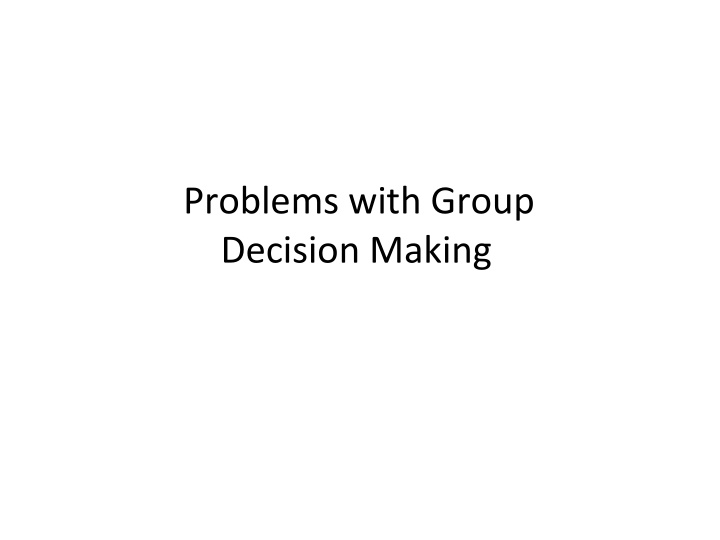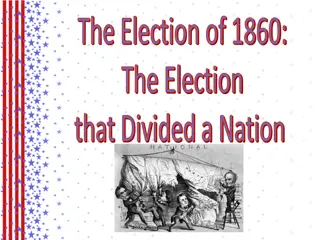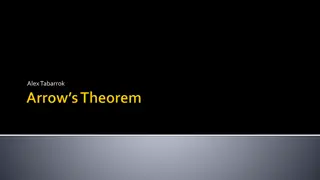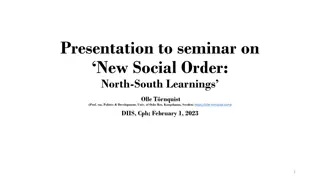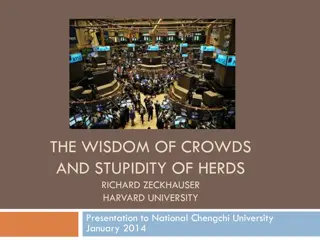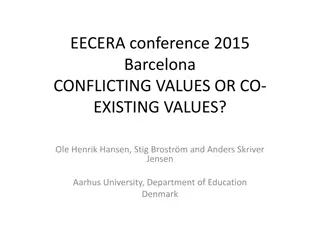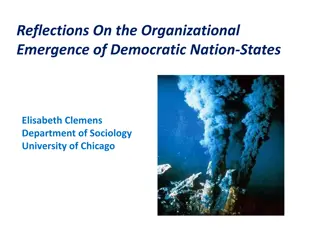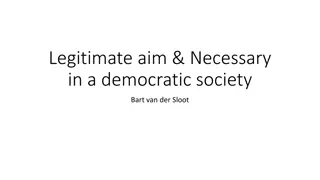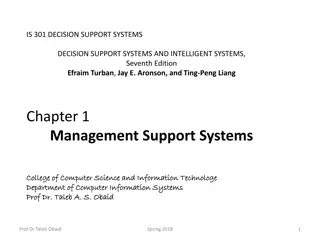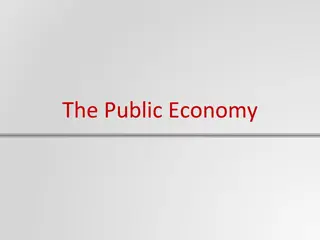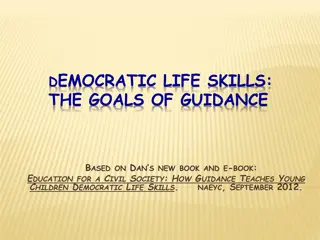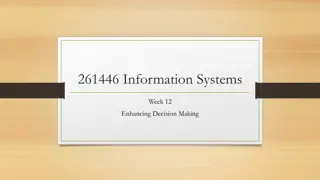Challenges in Group Decision Making and Democratic Systems
Challenges in group decision making within democratic systems are explored, with a focus on the two ways of evaluating political systems. While democracy is perceived as fair due to majority rule, social choice theory reveals complexities and paradoxes in aggregating individual preferences. The concept of rationality in decision-making is also examined through complete and transitive preference orderings.
Download Presentation

Please find below an Image/Link to download the presentation.
The content on the website is provided AS IS for your information and personal use only. It may not be sold, licensed, or shared on other websites without obtaining consent from the author.If you encounter any issues during the download, it is possible that the publisher has removed the file from their server.
You are allowed to download the files provided on this website for personal or commercial use, subject to the condition that they are used lawfully. All files are the property of their respective owners.
The content on the website is provided AS IS for your information and personal use only. It may not be sold, licensed, or shared on other websites without obtaining consent from the author.
E N D
Presentation Transcript
Problems with Group Decision Making
There are two ways of evaluating political systems: 1. Do institutions produce good outcomes? 2. Are the institutions good, fair, or just irrespective of the outcomes they produce?
Does the process by which democratic governments make decisions for everyone have appealing properties that make it morally or normatively attractive above and beyond any material benefits it might produce?
Many people like democracy because they believe it to be a fair way to make decisions. One commonsense notion of fairness is that group decisions should reflect the preferences of the majority of group members. Most people probably agree that a fair way to decide between two options is to choose the option that s preferred by the most people. At its heart, democracy is a system in which the majority rules.
Majority rule, though, is often a lot more complicated and less fair than our commonsense intuition about it might suggest.
Social choice theory addresses the voting procedures that govern and describe how individual preferences are aggregated to form a collective group preference.
An actor is rational if they possess a complete and transitive preference ordering over a set of outcomes.
An actor has a complete preference ordering if they can compare each pair of elements (call them x and y) in a set of outcomes in one of the following ways - either the actor prefers x to y, y to x, or they re indifferent between them. An actor has a transitive preference ordering if for any x, y, and z in the set of outcomes, it s the case that if x is weakly preferred to y, and y is weakly preferred to z, then it must be the case that x is weakly preferred to z.
Condorcets paradox illustrates that a group composed of individuals with rational preferences doesn t necessarily have rational preferences as a collective. Individual rationality isn t sufficient to ensure group rationality.
Imagine a city council made up of three individuals that must decide whether to: 1. Increase social services (I) 2. Decrease social services (D) 3. Maintain current levels of services (C)
City Council Preferences for the Level of Social Service Provision Left-wing councillors Centrist councillors Right-wing councillors I > C > D C > D > I D > I > C
Lets suppose the council employs majority rule to make its group decision. One possibility is a round-robin tournament. A round-robin tournament pits each competing alternative against every other alternative an equal number of times in a series of pair- wise votes.
Outcomes from the Round-Robin Tournament Round Contest Winner Majority that produced victory 1 Increase vs. decrease Centrist and right D 2 Current vs. increase Left and right I 3 Current vs. decrease Left and centrist C The group can t decide! Each alternative wins one round.
Outcomes from the Round-Robin Tournament Round Contest Winner Majority that produced victory 1 Increase vs. decrease Centrist and right D 2 Current vs. increase Left and right I 3 Current vs. decrease Left and centrist C A group of rational individuals is incapable of making a rational decision for the group as a whole. There s no majority to speak of a different majority supports the winning alternative or outcome in each round.
An Example of Cyclical Majorities The left-wing councillor proposes increasing spending, and the right- wing councillor goes along. Current Level The left-wing councillor proposes keeping the status quo, and the centrist councillor goes along. Increase The centrist councillor proposes decreasing spending, and the right- wing councillor goes along. Decrease
Our example demonstrates how a set of rational individuals can form a group with intransitive preferences. In the real world, though, we see deliberative bodies make decisions all the time and they don t appear to be stuck in an endless cycle. Why?
There are two broad reasons: 1. Preference orderings. 2. Decision-making rules.
There are two broad reasons: 1. Preference orderings. 2. Decision-making rules.
The councillors having a particular set of preference orderings. Suppose the right-wing councillor s preferences are instead a mirror image of the left-wing councillor s. Their preferences are now D > C > I instead of D > I > C.
If the right-wing councillors preferences are D > C > I, then C is a Condorcet winner. An option is a Condorcet winner if it beats all the other options in a series of pair-wise contests.
Majority rule isnt necessarily incompatible with rational group preferences. Condorcet s Paradox only shows that it s possible for a group of individuals with transitive preferences to produce a group that behaves as if it has intransitive preferences.
How often are individuals likely to hold preferences that cause intransitivity?
Proportion of Possible Strict Preference Orderings without a Condorcet Winner Number of voters Number of alternatives 3 5 7 9 11 Limit 3 0.056 0.069 0.075 0.078 0.080 0.088 4 0.111 0.139 0.150 0.156 0.160 0.176 5 0.160 0.200 0.215 0.251 6 0.202 0.315 Limit 1.000 1.000 1.000 1.000 1.000 1.000
In general, we cant rely on majority rule to produce a coherent sense of what the group wants, especially if there are no institutional mechanisms for keeping the number of voters small or weeding out some of the alternatives.
Many political decisions involve bargaining and hence an infinite number of alternatives!
Condorcets Paradox indicates that restricting group decision making to sets of rational individuals is no guarantee the group as a whole will exhibit rational tendencies. Group intransitivity is unlikely when the set of feasible options is small, but is almost certain when the set of feasible alternatives gets large. As a result, it s impossible to say that the majority decides except in very restricted circumstances.
The analytical insight from Condorcets Paradox suggests that group intransitivity should be common. But we observe a surprising amount of stability in group decision making in the real world.
Perhaps this has something to do with the decision-making rules that we use. 1. Preference orderings. 2. Decision-making rules.
The Borda count asks individuals to rank potential alternatives from their most to least preferred and then assign points to reflect this ranking. The alternative with the most points wins.
Determining the Level of Social Service Provision using the Borda Count Points awarded Alternative Left-wing Centrist Right-wing Borda count total Increase spending 3 1 2 6 Decrease spending 1 2 3 6 Current spending 2 3 1 6 Using the same preferences as before, the Borda count doesn t provide a clear winner either.
A more troubling aspect of this decision rule can be seen if we consider the introduction of a fourth alternative, future cuts (FC). Left-wing Centrist Right-wing I > C > D > FC C > D > FC > I D > FC > I > C Note: I = an increase in social service provision; D = a decrease in social service provision; C = a maintenance of cur- rent levels of social service provision; FC = future cuts in social service provision; > means is strictly preferred to.
Points awarded Borda count total Alternative Left-wing Centrist Right-wing Increase spending 3 0 1 4 Decrease spending 1 2 3 6 Current spending 2 3 0 5 Future cuts in spending 0 1 2 3 The Borda count now produces a clear winner! The choice has been influenced by the introduction of what might be called an irrelevant alternative.
Decision rules that arentindependent of irrelevant alternatives allow wily politicians to more easily manipulate the outcome of a decision making process to produce their most preferred outcome. Rather than making persuasive arguments about the desirability of their most preferred outcome, a politician might get their way by the imaginative introduction of an alternative that has no chance of winning, but that can influence the alternative that s ultimately chosen.
Agenda Setting An alternative decision-making mechanism that overcomes the potential instability of majority rule in round-robin tournaments requires actors to begin by considering only a subset of the available pair-wise alternatives.
A voting agenda is a plan that determines the sequence or order in which votes occur. One possible voting agenda: First round: I vs. D. Second round: Winner of first round vs. C.
Pair-Wise Contests and Different Voting Agendas Councillor obtaining their most preferred outcome 1st-round winner 2nd-round winner Agenda 1st round 2nd round 1 I vs. D D vs. C Centrist councillor D C 2 C vs. I I vs. D Right-wing councillor I D 3 C vs. D C vs. I Left-wing councillor C I If everyone votes sincerely, the agenda setter can get their most preferred outcome. The agenda setter is a dictator!
But should we expect all the councillors to vote sincerely? A sincere vote is a vote for an individual s most preferred option. A strategic or sophisticated vote is a vote in which an individual votes in favor of a less preferred option because they believe doing so will ultimately produce a more preferred outcome.
Agenda 1: I vs. D, with winner against C. The councillors know the second round will involve either D vs. C (C wins) or I vs. C (I wins). Thus, the councillors know that if D wins the first round, the outcome will be C, and that if I wins the first round, the outcome will be I. This means that the first round of voting is really a contest between C and I (even if they re voting on I and D).
Put yourself in the shoes of the right-wing councillor: D > I > C. If they votes for their preferred option (D) in the first round, they ll end up with C (their worst preferred option) as the final outcome. Thus, they have a strong incentive to vote strategically for I in the first round, since this will lead to I (their second preferred option) as the final outcome. Some analysts find strategic voting lamentable and prefer decision rules that induce sincere voting.
Weve seen that its possible to avoid the potential for group intransitivity by imposing a voting agenda.
Unfortunately, the outcome of such a process is extremely sensitive to the agenda chosen, and, consequently, either of two things is likely to happen: 1. The instability of group decision making shifts from votes on outcomes to votes on the agendas expected to produce those outcomes. 2. Some subset of actors is given power to control the agenda and, therefore, considerable influence over the outcome likely to be produced.
Power of the agenda setter: Their ability to specify a particular sequence of votes over the available alternatives. But also their ability to determine the set of available alternatives that can be voted on in the first place.
With elections and referenda, voters only get to vote for the alternatives that appear on the ballot. But who decided that these would be the only choices? Why don t other choices appear on the ballot? If the set of ballot alternatives is restricted and thus doesn t reflect the full range of voter preferences, how can we ever be confident in claiming the outcome of some vote reflects the will of the majority?
UK Brexit Referendum, 2016: It s not possible to know whether the Brexit decision was an accurate reflection of voter preferences and hence the revelation of the will of the people or whether it simply reflects the institutional choices of the agenda setters who chose to hold a referendum and restrict the options to the two that appeared on the ballot.
Restrictions on Preferences: The Median Voter Theorem
Another way in which stable outcomes might be produced is to restrict the preferences that actors can have.
Its possible to convey an individuals preference ordering in terms of a utility function. A utility function is essentially a numerical scaling in which higher numbers stand for higher positions in an individual s preference ordering.
